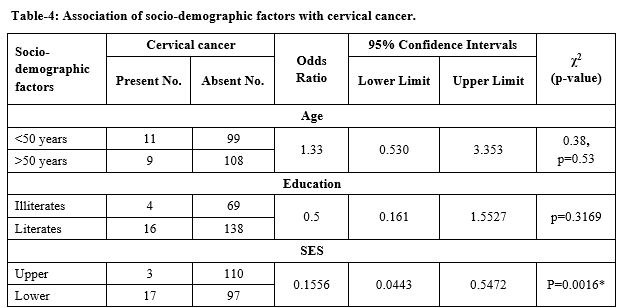Profile of cancer patients attending a tertiary care center
Abstract
Introduction: In India, around 555,000 people died of cancer in the year 2010. Cancer is a major cause of morbidity and mortality in developing and developed countries. In many low-income and middle-income countries, including India, most of the population does not have access to a well organized and well-regulated cancer care system.
Objective: (1) To study the socio-demographic profile of cancer patients attending tertiary care center.(2) To study the type, site and at what stage cancers are being reported to tertiary care center (3) To study the association of the cancer type with socio-demographic variables.
Material and methods: A Hospital-based Cross-Sectional Study carried out from November 2013 to October 2014. Detailed pre-designed and pre-tested proforma is used to collect information on the socio-demographic profile. All diagnosed cancer patients admitted at SDM College of Medical Sciences and Hospital. A total of 381 were studied during the study period.
Results: Total of the 381 cancer patients, Males were 154 (40.4%) and females were 227 (59.6%), it was found that majority of male, 78 (50.6%) study subjects were in the age group of 60-69 years, in socioeconomic status male subjects were in lower-middle and upper lower class i.e. 40 (26%) female were in upper-middle-class i.e. 70 (30.8%), according to the present study breast cancer (21.3%) was most prevalent, followed by CA liver and biliary tract (14.7%), followed by lungs (8.7%). the male was diagnosed in stage III of disease accounting 67(43.5%) female patients were diagnosed in stage II 86 (37.9).
Conclusion: Breast cancer more common among younger age group and upper SES, Cervical cancer more common among lower SES, Lung cancer in literates’. Liver cancer more common among the older age group and lower SES. So, these groups can be targeted for health education and screening for early diagnosis and treatment.
Downloads
References
Cancer in Developing Countries - INCTR – International Network for Cancer Treatment and Research [Internet]. Available from: http://www.inctr.org/about-inctr/cancer-in-developing-countries/.
Fact Sheets by Cancer [Internet]. [cited 2015 Mar 16]. Available from: http://globocan.iarc.fr/Pages/fact_sheets_cancer.aspx.
Mallath MK, Taylor DG, Badwe RA, Rath GK, Shanta V, Pramesh CS, et al. The growing burden of cancer in India: epidemiology and social context. Lancet Oncol. 2014;15(6):e205–e212. doi: https://doi.org/10.1016/s1470-2045(14)70115-9.
http://www.breastcancerindia.net/statistics/stat_global.html. Statistics of Breast Cancer in India: Global Comparison [Internet]. Available from: http://www.breastcancerindia.net/statistics/stat_global.html.
Khanna A. Current Status of Cancer Burden: Global and Indian Scenario. Biomed Res J. 2014;1(1):1-5.
Ashat M, Goel N, Puri S, Pandey A, Singh A, Kaushal V. Socio-demographic characteristics of cancer patients: Hospital based cancer registry in a tertiary care hospital of India. Indian J Cancer. 2014;51(1):1-4. doi: https://doi.org/10.4103/0019-509X.134593.
Wani M, Jan F, Khan N, Pandita K, Khurshid R, Khan S. Cancer trends in Kashmir; common types, site incidence and demographic profiles: National Cancer Registry 2000-2012. Indian J Cancer. 2014;51(2):133-137. doi: https://doi.org/10.4103/0019-509X.138188.
Bangal R, Giri P, Bangal S, More M, Singh K. Socio-demographic profile and associated risk factors in cancer patients attending the Oncology OPD of a tertiary care teaching hospital in Western Maharashtra, India. Int J Med Sci Public Heal. 2014;3(12):1.
Kalyani R, Das S, Singh B., Kumar H. Cancer profile in the department of pathology of sri devaraj urs medical college, Kolar: A ten years study. Indian J Cancer. 2010;47(2):160-165. doi: https://doi.org/10.4103/0019-509X.63011.
World Health Organization, Publications,The Global Adult Tobacco Survey (GATS) India, 2009-2010. Available at https://www.who.int/tobacco/surveillance/gats_rep_egypt.pdf.
Rajesh N, Sreelakshmi K, Ramesh K. Profile of oral cancer patients attending tertiary care hospital, Bellary, Karnataka, India. Int J Curr Res Aca Rev. 2014;2(8):46-52.
Suthahar A, Gurpreet K, Ambigga D, Maniam T, Dhachayani S, Fuad I, et al. A profile of cancer patient outcomes from a tertiary care teaching hospital in Malaysia. Singapore Med J. 2009;50(7):720-723.
Kaku M, Mathew A, Rajan B. Impact of socio-economic factors in delayed reporting and late-stage presentation among patients with cervix cancer in a major cancer hospital in South India. Asian Pac J Cancer Prev. 2008;9(4):589-594.
NCRP - Three-Year Report of Population Based Cancer Registries 2009-2011, National Cancer Registry Programme (Indian Council of Medical Research), Bangalore, 2013. http://www.ncrpindia.org/ALL_NCRP_REPORTS/HBCR_REPORT_2007_2011/index.htm. 2015.
Kaur N, Attam A, Saha S, Bhargava SK. Breast Cancer Risk Factor Profile in Indian Women. JIMSA; 2011;24(4):163-165.
Neal RD, Allgar VL. Sociodemographic factors and delays in the diagnosis of six cancers: analysis of data from the “National Survey of NHS Patients: Cancer.” Br J Cancer. 2005;92(11):1971-1975. doi: https://dx.doi.org/10.1038%2Fsj.bjc.6602623.
Thulaseedharan J V., Malila N, Hakama M, Esmy PO, Cheriyan M, Swaminathan R, et al. Socio Demographic and Reproductive Risk Factors for Cervical Cancer - a Large Prospective Cohort Study from Rural India. Asian Pacific J Cancer Prev. 2012;13(6):2991-2995. doi: https://doi.org/10.7314/apjcp.2012.13.6.2991.

Copyright (c) 2020 Author (s). Published by Siddharth Health Research and Social Welfare Society

This work is licensed under a Creative Commons Attribution 4.0 International License.


 OAI - Open Archives Initiative
OAI - Open Archives Initiative


